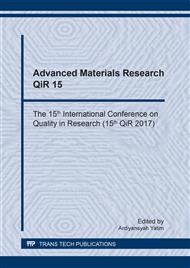p.158
p.171
p.177
p.186
p.191
p.200
p.209
p.218
p.225
Study on Nugget Growth in Resistance Spot Welding of Thin Aluminum A1100 Using Welding Simulation
Abstract:
Resistance spot welding (RSW), generally which is one of the most often used to joint metal plate in the automotive and aviation industries. RSW welding process involves electrical, thermal mechanical, metallurgy, and complex surface phenomenon. Unlike the other welding processes, weld joint formation in RSW process occurs very quick (in milli-seconds) and took place between the workpieces overlap each other. Welding simulation allows visual examination of the weld joint without having to perform an expensive experiment. Weld nugget size is the most important parameter in determining the mechanical behavior of welded joints in RSW process. The quality and strength of the weld joint in RSW process is predominantly determined by the shape and size of the weld nugget. Simulation modeling of RSW process performed using ANSYS Parametric Design Language (APDL) module based on the finite element method (FEM), embedded in ANSYS Workbench. Electrical and transient-thermal interaction was developed to study the weld nugget growth on resistance spot welding of aluminum A1100 metal plate with a thickness of 0.4 mm respectively. Weld nugget diameter can be well predicted by using this simulation model from the temperature distribution during the welding process. Welding is performed by varying the weld current (1 kA and 2 kA) and the welding time for each electric current, which are start from 0.5, 1.0, and 1.5 cycle time. Nugget diameter for each of the welding parameters from the simulation modelling were 4,276 mm, 4,372 mm, 4,668 mm, 5,616 mm and 5,896 mm. Weld expulsion occurred for the specimen with welding current 2 kA and welding time 1.5 cycle time, characterized by the decreasing of the tensile-shear strength of the specimen.
Info:
Periodical:
Pages:
191-199
Citation:
Online since:
August 2018
Price:
Сopyright:
© 2018 Trans Tech Publications Ltd. All Rights Reserved
Share:
Citation:


